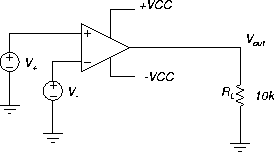 |
As you can see, we can do a lot with opamps using the ideal model: V+=V- and i+=i-=0. This ignores detailed behaviour such as saturation, etc, and assumes the opamp is an a negative feedback configuration.
In contrast, open loop means no feedback. We will look at some of the opamp's detailed behaviour when it is in open loop.
Load the PSPICE file opamp1.sch, shown in Figure 18.
Simulate the circuit and obtain the graph of Figure 19.
In this experiment, V- = 0 V and V+ varies over a range of values (DC sweep), and the output voltage is graphed.
Determine from the graph the range of values of V+ for which the 741 device is not saturated.
Determine from the graph the open loop gain of the opamp.
Determine the offset voltage
![]() (we don't normally consider this in this course but it is readily
apparent in the open loop configuration).
(we don't normally consider this in this course but it is readily
apparent in the open loop configuration).
With V- = 0 V and
![]()
![]() V simulate and graph the
input current i+ and determine the input resistance
(c.f. D& S, pp239).
V simulate and graph the
input current i+ and determine the input resistance
(c.f. D& S, pp239).
With V- = 0 V and V+ =0 V, replace the resistor by a voltage source for a range of voltages, say -2 to +2 V. Simulate and graph the output current versus this voltage and determine the output resistance.
Now determine the model of
Figure 20.
ANU Engineering - ENGN2211